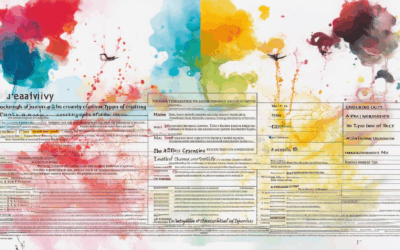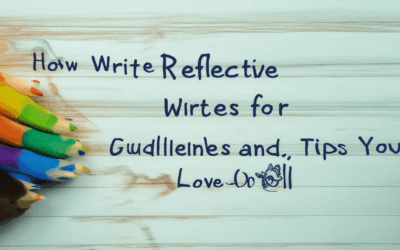Unlocking personal growth and fostering deeper self-awareness has never been more accessible than through the power of reflective writing exercises. In today’s fast-paced world, the ability to pause, reflect, and grow is invaluable, and nowhere is this more evident than in the art of reflective writing. Whether you’re a student, a professional, or someone embarking on a journey of self-discovery, mastering reflective writing exercises can transform how you process experiences, articulate emotions, and cultivate meaningful insights.
Key Takeaways
- Master Reflective Writing with Proven Steps: Follow the seven systematic steps to craft a meaningful reflection paper, ensuring clarity and depth in your writing.
- Craft a Cohesive Reflection Paper Structure: Understand the three-part structure—introduction, body, and conclusion—to organize your thoughts effectively.
- Adhere to Essential Guidelines for Quality: Follow the three key rules of reflective writing to maintain coherence and precision in your expressions.
- Foster Personal Growth Through Insights: Use reflective writing to gain self-awareness and transform your perspective on various topics.
- Enhance Expression with Depth and Authenticity: Incorporate personal anecdotes and connect your experiences to broader themes for richer narratives.
- Refine Your Process for Better Results: Revise your drafts, seek feedback, and polish your work to achieve polished outcomes.
- Elevate Your Writing with Transformative Techniques: Explore reflective exercises to expand your expressive capabilities and deepen your understanding.

The 5 R’s of Reflective Writing
Reflective writing is a powerful tool for self-reflection, personal growth, and deepening understanding. It involves examining your thoughts, feelings, and experiences to foster insight and meaning. Below are the five key components of reflective writing, often referred to as the “5 R’s”:
- Report : This involves documenting your experiences in a factual and unbiased manner. It’s like taking notes or keeping a journal entry without judgment or interpretation. Effective reporting ensures that your thoughts are captured accurately for future review.
- Respond : In this stage, you engage with your thoughts and emotions. It’s about questioning assumptions, exploring feelings, and considering alternative perspectives. Responding helps you move beyond surface-level observations to deeper insights.
- Relate : Connecting your experiences to broader themes, patterns, or universal concepts. This step involves drawing parallels between your life and the world around you, helping you see your personal journey within a larger context.
- Reason : Analyzing and evaluating your thoughts and experiences. This includes logical thinking, identifying causes and effects, and making connections between ideas. Reasoning allows you to uncover underlying meanings and patterns.
- Reconstruct : Finally, you piece together your reflections into a coherent narrative. This involves organizing your thoughts, creating a story or theme, and communicating your findings effectively. Reconstruction turns raw materials into something meaningful and shareable.
By practicing these five steps, you can transform raw experiences into rich, insightful reflections that enrich your personal and professional life. Silken Drum encourages writers to explore these techniques to unlock their full potential and share their unique voices with the world. Explore our resources on reflective writing to discover more tools and techniques for your journey.
What are the Four Cs of Reflective Practice?
The Four Cs of Reflective Practice, as outlined by the 4 Cs framework, provide a structured approach to enhance teaching and learning through reflection. These components are:
- Continuous Reflection – Reflecting regularly and consistently to identify strengths and areas for improvement.
- Connected Reflection – Integrating reflection into daily routines and connecting it with broader professional goals and collaborative efforts.
- Challenging Reflection – Engaging in reflective practices that address complex and challenging situations, fostering personal and professional growth.
- Contextualized Reflection – Considering the specific context and environment when reflecting to tailor approaches to individual needs and circumstances.
This framework emphasizes the importance of a dynamic and holistic approach to reflection, ensuring that educators can effectively analyze and adapt their practices based on real-world experiences.

What is a Good Reflection Exercise?
Reflection is a powerful tool for self-awareness and personal growth. A good reflection exercise helps you examine your thoughts, emotions, and experiences to gain insight and foster growth. Here’s a structured approach to effective reflection:
Components of a Good Reflection Exercise
- Gratitude Practice : Begin by jotting down three things you’re grateful for each day. This shifts focus to positivity and helps cultivate a mindset of abundance.
- Self-Assessment : Reflect on your accomplishments and areas for improvement. Ask yourself what you’ve done well and what you’d like to change moving forward.
- Goal Tracking : Review your daily actions against your long-term goals. Consider how your choices align with your aspirations and adjust accordingly.
- Mindfulness Meditation : Take a few moments to be present, acknowledging your feelings without judgment. This enhances self-awareness and emotional intelligence.
- Journaling : Write freely about your experiences, challenges, and thoughts. Journaling allows for deeper exploration and serves as a record of your journey.
How to Make Reflection Effective
- Consistency : Aim to reflect daily, even if briefly, to build a habit that supports ongoing self-awareness.
- Structured Prompts : Use prompts like “What went well today?” or “What could I have done differently?” to guide your reflection.
- Examples of Techniques : Explore methods such as visualization or mindfully observing your surroundings to enrich your practice.
- Consider Technology : Utilize reflection apps that offer guided exercises and prompts to facilitate consistent practice.
By incorporating these elements, you can create a meaningful reflection exercise tailored to your personal growth and well-being.

What Are the 7 Steps to Writing a Reflection Paper?
Here’s a step-by-step guide to crafting an effective reflection paper:
- Understand the Assignment : Begin by carefully reading the prompt and understanding what is required. Clarify any questions with your instructor to avoid misunderstandings and ensure you meet all requirements.
- Brainstorm Ideas : Reflect on your thoughts, experiences, and observations. Use techniques like mind mapping or freewriting to generate ideas. Focus on unique perspectives and personal connections to the topic.
- Choose a Structure : Decide on the organizational structure that best fits your reflection. Common structures include chronological, cause-and-effect, problem-solution, or narrative approaches.
- Gather Evidence : Collect supporting evidence from your personal experiences, textbooks, lectures, or credible sources. Organize these materials into relevant categories to support your points.
- Write the Introduction : Craft a compelling opening paragraph that grabs attention and states your thesis. Clearly articulate the purpose of your reflection and provide background information.
- Elaborate on Each Point : Expand on each of your main ideas with detailed explanations, examples, and analysis. Use quotes, statistics, or anecdotes to strengthen your arguments.
- Revise and Edit : Read through your draft carefully and make revisions for clarity, coherence, and grammar. Ensure your tone matches the required style (e.g., academic, personal, or analytical). Consider seeking feedback from peers or instructors to refine your work.
By following these steps, you can create a well-structured and meaningful reflection paper that effectively communicates your thoughts and insights. Learn more about writing reflection papers on Silken Drum .
The Three Basic Parts of a Reflection Paper
A reflection paper typically consists of three primary components, each serving a distinct purpose in conveying thoughtfully analyzed ideas. These components work together to create a cohesive and meaningful piece of academic writing.
- Introduction
- The introduction sets the stage for the reflection by briefly presenting the topic or event being discussed.
- It often includes a hook to grab the reader’s attention, followed by a clear thesis statement that outlines the central idea or argument of the paper.
- The introduction may also provide background information or context necessary for understanding the reflection.
- Body
- The body is the most extensive part of the reflection paper, where the author delves into personal experiences, emotions, and observations.
- This section is often divided into paragraphs where the author analyzes specific incidents or moments, connects them to broader themes or theories, and explores their implications.
- Personal anecdotes and connections to existing literature or theoretical frameworks are commonly included to add depth and authenticity to the reflection.
- Conclusion
- The conclusion summarizes the key points discussed in the body and reflects on the overall experience or learning gained from the reflection.
- It may also discuss how the insights obtained from the process can influence future actions, behaviors, or beliefs.
- Finally, the conclusion provides a sense of closure by reiterating the central theme or message of the paper.
By following this structure, authors can effectively communicate their thoughts, emotions, and growth through a well-organized reflection paper.

Reflection Rules
Here are the three reflection rules in mathematics:
- Reflecting Points Over Axes
- When reflecting a point over the x-axis, the y-coordinate changes sign: (x, y) becomes (x, -y).
- When reflecting a point over the y-axis, the x-coordinate changes sign: (x, y) becomes (-x, y).
-
Function Symmetry Properties
- An even function satisfies f(-x) = f(x), indicating symmetry over the y-axis.
- An odd function satisfies f(-x) = -f(x), indicating symmetry over the origin.
-
Graph Transformation via Reflection
- Reflecting a graph over its axis of symmetry transforms it into its mirror image. For example, reflecting a parabola over its vertex axis reverses its opening direction.
These rules are fundamental in understanding geometric transformations and symmetries in mathematical analysis.




0 Comments